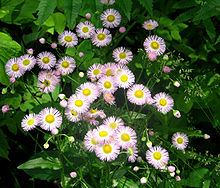Erigeron philadelphicus: Difference between revisions
m →Description: Per consensus in discussion at Talk:New York#Proposed action to resolve incorrect incoming links, replaced: New York → New York using AWB |
Rescuing 1 sources and tagging 0 as dead. #IABot (v1.2.7.1) |
||
| Line 22: | Line 22: | ||
|}} |
|}} |
||
'''''Erigeron philadelphicus''''', the '''Philadelphia fleabane''', is a widespread North American [[plant]] in the [[Asteraceae|daisy family]]. Also known as '''common fleabane''', '''daisy fleabane''', '''frost-root''', '''marsh fleabane''', '''poor robin's plantain''', '''skervish''',<ref name=usda>[http://plants.usda.gov/plantguide/pdf/cs_erph.pdf ''Erigeron philadelphicus''.] United States Department of Agriculture NRCS Plant Guide.</ref> and in the British Isles as '''robin's-plantain'''.<ref name=BSBI07>{{cite web |
'''''Erigeron philadelphicus''''', the '''Philadelphia fleabane''', is a widespread North American [[plant]] in the [[Asteraceae|daisy family]]. Also known as '''common fleabane''', '''daisy fleabane''', '''frost-root''', '''marsh fleabane''', '''poor robin's plantain''', '''skervish''',<ref name=usda>[http://plants.usda.gov/plantguide/pdf/cs_erph.pdf ''Erigeron philadelphicus''.] United States Department of Agriculture NRCS Plant Guide.</ref> and in the British Isles as '''robin's-plantain'''.<ref name=BSBI07>{{cite web|title=BSBI List 2007 |publisher=Botanical Society of Britain and Ireland |url=http://www.bsbi.org.uk/BSBIList2007.xls |format=xls |archive-url=http://www.webcitation.org/6VqJ46atN?url=http://www.bsbi.org.uk/BSBIList2007.xls |archive-date=2015-02-25 |accessdate=2014-10-17 |deadurl=yes |df= }}</ref> It is native to North America and found there in nearly all of the United States and Canada.<ref>[http://bonap.net/MapGallery/State/Erigeron%20philadelphicus.png Biota of North America Program 2014 state-level distribution map]</ref> It is also introduced into Europe and Asia, considered an invasive weed in many places.<ref>[http://luirig.altervista.org/flora/taxa/index1.php?scientific-name=erigeron+philadelphicus Altervista Flora Italiana, Cespica di Philadelfia ''Erigeron philadelphicus'' L.] includes photos and line drawings</ref> |
||
== Description == |
== Description == |
||
Revision as of 17:00, 25 December 2016
| Philadelphia fleabane | |
|---|---|

| |
| Ottawa, Ontario, Canada | |
| Scientific classification | |
| Kingdom: | |
| (unranked): | |
| (unranked): | |
| (unranked): | |
| Order: | |
| Family: | |
| Tribe: | |
| Genus: | |
| Species: | E. philadelphicus
|
| Binomial name | |
| Erigeron philadelphicus | |
| Synonyms[1][2] | |
| |
Erigeron philadelphicus, the Philadelphia fleabane, is a widespread North American plant in the daisy family. Also known as common fleabane, daisy fleabane, frost-root, marsh fleabane, poor robin's plantain, skervish,[3] and in the British Isles as robin's-plantain.[4] It is native to North America and found there in nearly all of the United States and Canada.[5] It is also introduced into Europe and Asia, considered an invasive weed in many places.[6]
Description

Erigeron philadelphicus is a herbaceous plant with alternate, simple leaves, on hairy stems. The flower heads are borne in spring in arrays of as many as 35 heads. Each head may sometimes contain as many as 400 pink or white ray florets surrounding numerous yellow disc florets. The blooms are less than one inch (2.5 cm) in diameter. The stem is hairy with rough hairs. The middle to lower leaves are heart shaped, and the plant is about 0.5–2.5 ft (15–76 cm) tall. Its active growth period is from spring to summer (April to July). This plant grows on roadsides, in fields, in thickets, and in open woods.[7][8]
- Varieties
- Erigeron philadelphicus var. glaber J.K.Henry - British Columbia
- Erigeron philadelphicus Linnaeus var. philadelphicus - most of species range
- Erigeron philadelphicus var. provancheri (Victorin & J. Rousseau) B. Boivin - Ontario, Québec; New York, Vermont
References
- ^ The Plant List, Erigeron philadelphicus L.
- ^ Tropicos, Erigeron philadelphicus L.
- ^ Erigeron philadelphicus. United States Department of Agriculture NRCS Plant Guide.
- ^ "BSBI List 2007". Botanical Society of Britain and Ireland. Archived from the original (xls) on 2015-02-25. Retrieved 2014-10-17.
{{cite web}}: Unknown parameter|deadurl=ignored (|url-status=suggested) (help) - ^ Biota of North America Program 2014 state-level distribution map
- ^ Altervista Flora Italiana, Cespica di Philadelfia Erigeron philadelphicus L. includes photos and line drawings
- ^ Flora of North America, Erigeron philadelphicus Linnaeus, 1753. Philadelphia fleabane, vergerette de Philadelphie
- ^ Dickinson, T.; Metsger, G.; Hull, J.; and Dickinson, R. (2004) The ROM Field Guide to Wildflowers of Ontario. Toronto:Royal Ontario Museum, p. 163.
External links
